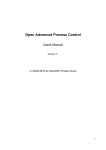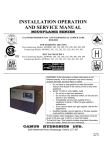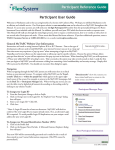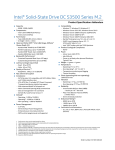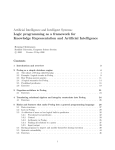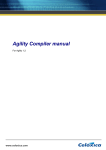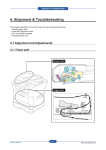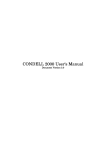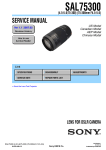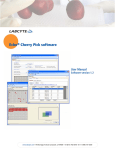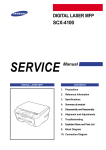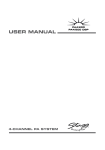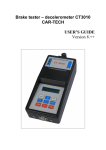Download type approval criteria specification
Transcript
engineering your software solutions VOSA Type Approval Testing for Portable and Garage Equipment Devices TYPE APPROVAL CRITERIA SPECIFICATION Version 8 Date 4th September 2009 Prepared by Rick Hewes ZSL Approval Mark Parsons Customer Approval James Body The contents of this document are confidential between Zircon Software Limited and VOSA. The document may not be reproduced or copied in any manner without the permission of Zircon Software Limited and VOSA. CONTROLLED DISTRIBUTION Type Approval Testing for Portable and Garage Equipment Devices Type Approval Criteria Specification 4th September 2009 (Issue 8) engineering your software solutions Copy No. Held by 1 Zircon Software Limited 2 VOSA Controlled copies are kept up to date by the Project Manager. Users of uncontrolled copies must ensure that their copy is up to date for the purposes of its use. REVISION HISTORY Issue Date Author CR Revisions 0A 16/04/07 Matt Lee N/A Initial version for review 0B 25/05/07 Matt Lee N/A Changes following meeting with Trevor Drawbridge and internal review comments. 0C 30/05/07 Matt Lee N/A Changes following internal quality review. 0D 31/05/07 Matt Lee N/A Minor changes following review check. 0E 20/06/07 Matt Lee N/A Changes following VOSA review. 1 11/07/07 Matt Lee N/A Issued following VOSA review. 1A 28/09/07 Matt Lee 161/002 Changes following discussion on Brake & Validation Rules with Trevor Drawbridge 161/004 (VOSA). 1B 24/10/07 Matt Lee 161/002 Changes following discussion on Brake Validation Rules with Steve Duff (VOSA). & 161/004 1C 5/11/07 Matt Lee 161/002 Changes following discussions with Zircon developers. & 161/004 COMMERCIAL IN CONFIDENCE Page 2 of 46 Type Approval Testing for Portable and Garage Equipment Devices Type Approval Criteria Specification 4th September 2009 (Issue 8) engineering your software solutions 1D 21/11/07 Matt Lee 161/002 Changes following review by Trevor & Drawbridge (VOSA). 161/004 1E 21/11/07 Matt Lee 161/002 Change resulting from clarification & regarding the mixing of Imbalance Data 161/004 types. 2 3/12/07 Matt Lee 161/002 Issued following review. & 161/004 2A 13/12/07 Matt Lee 161/016 Changes following run through at FAT 3 28/01/08 Matt Lee 161/016 Issued following FAT. 3A 04/02/08 Matt Lee 161/018 Minor change following request for clarification on the use of VSI brake weight by VOSA. 3B 26/02/08 Matt Lee 161/019 Minor change requested by VOSA regarding removal of statement concerning non‐ component advisories. 4 04/03/08 Matt Lee 161/018 Issued following VOSA review. and 161/019 4A 10/03/08 Rick Hewes 161/020 Changed to meet interface changes. and 161/021 4B 25/03/08 Rick Hewes 161/020 Changed following review. and 161/021 5 26/03/08 Rick Hewes 161/020 Issued following review. and 161/021 COMMERCIAL IN CONFIDENCE Page 3 of 46 Type Approval Testing for Portable and Garage Equipment Devices Type Approval Criteria Specification 4th September 2009 (Issue 8) engineering your software solutions 5A 06/10/08 Rick Hewes 161/029 Added AxleConfig & PBAxles elements to Class III, IV, V, VII vehicles. 5B 06/10/08 Rick Hewes 161/029 Updated following review. 6 16/10/08 Rick Hewes 161/029 Issued following review. 6A 8/01/09 Rick Hewes 161/032 Changed to meet Garage Equipment requirements and review comments. 6B 02/02/09 Rick Hewes 161/032 Updated following review. 7 09/03/09 Rick Hewes 161/032 Issued following VOSA acceptance. 7A 18/08/09 Rick Hewes 161/034 Updated following review. 8 04/09/09 Rick Hewes 161/034 Issued following VOSA acceptance. COMMERCIAL IN CONFIDENCE Page 4 of 46 Type Approval Testing for Portable and Garage Equipment Devices Type Approval Criteria Specification 4th September 2009 (Issue 8) engineering your software solutions CONTENTS 1 1.1 1.2 1.3 1.4 INTRODUCTION .......................................................................................................... 7 BACKGROUND .............................................................................................................. 7 SCOPE OF THE DOCUMENT ...................................................................................... 7 GLOSSARY OF ABBREVIATIONS & TERMS USED ................................................ 8 DOCUMENT REFERENCES ....................................................................................... 10 2 2.1 2.2 2.3 COMPLIANCE LEVELS ............................................................................................. 11 INTRODUCTION.......................................................................................................... 11 TESTING DEVICE......................................................................................................... 11 REFERENCE DEVICE .................................................................................................. 11 3 3.1 3.2 REQUIREMENTS......................................................................................................... 12 INTRODUCTION.......................................................................................................... 12 VTS DEVICE INTERFACE........................................................................................... 12 3.2.1 Requirements .................................................................................................... 12 DOWNLOADED DOCUMENTATION..................................................................... 14 3.3.1 Requirements .................................................................................................... 15 VEHICLE IDENTIFICATION INFORMATION....................................................... 16 3.4.1 Requirements .................................................................................................... 16 INSPECTION ITEMS .................................................................................................... 17 3.5.1 Requirements .................................................................................................... 17 TEST RESULTS .............................................................................................................. 20 3.6.1 Requirements .................................................................................................... 20 ERROR HANDLING .................................................................................................... 20 3.7.1 Requirements .................................................................................................... 21 USER SUPPORT AND UPDATES .............................................................................. 21 3.8.1 Requirements .................................................................................................... 21 USER INTERACTION .................................................................................................. 22 3.9.1 Requirements .................................................................................................... 22 3.3 3.4 3.5 3.6 3.7 3.8 3.9 4 4.1 4.2 4.3 4.4 4.5 4.6 4.7 TIPS AND GUIDELINES FOR DEVELOPERS...................................................... 24 INTRODUCTION.......................................................................................................... 24 AUTOMATIC STATUS CHECK AND UPDATE ..................................................... 24 SOFTWARE UPDATES ................................................................................................ 24 COMPONENT HIERARCHY...................................................................................... 24 VEHICLE CLASS ASSOCIATION.............................................................................. 25 NON‐COMPONENT ADVISORIES........................................................................... 25 ERROR HANDLING .................................................................................................... 26 4.7.1 Service Name .................................................................................................... 26 5 BRAKE TEST VALIDATION .................................................................................... 27 COMMERCIAL IN CONFIDENCE Page 5 of 46 Type Approval Testing for Portable and Garage Equipment Devices Type Approval Criteria Specification 4th September 2009 (Issue 8) engineering your software solutions 5.1 5.2 INTRODUCTION.......................................................................................................... 27 BRAKE TEST RESULTS APPLICABILITY ................................................................ 27 5.2.1 Brake Weight Data ........................................................................................... 38 5.2.2 Brake Weight Sources ...................................................................................... 38 5.2.3 Brake Result Structures.................................................................................... 44 6 NON‐BRAKE RESULT VALIDATION ................................................................... 46 COMMERCIAL IN CONFIDENCE Page 6 of 46 Type Approval Testing for Portable and Garage Equipment Devices Type Approval Criteria Specification 4th September 2009 (Issue 8) engineering your software solutions 1 1.1 INTRODUCTION BACKGROUND The MOT computerisation project is a major project that has been carried out by Siemens on behalf of VOSA. The system is currently fully operational and is in a “Business as Usual” state. In order to aid user efficiency, the system is being enhanced to support the use of bespoke Devices, which will enable a nominated tester carrying out a MOT test to enter data as the testing progresses or by trade personnel to access documents and data for reference purposes. The Devices also enable the tester to upload the entered test data to the Vehicle Testing Station (VTS) Device and must implement the interface specified by the Technical Interface Definition Hand Held Devices Specification [2]. VOSA wish to limit their direct involvement in the type approval process for these Devices and consequently have placed a contract with Zircon Software Limited (ZSL) to carry out the Type Approval of any developed Devices. ZSL is to provide a point of initial contact to the developers of Devices and to carry out Type Approval Testing, prior to the Devices being marketed and sold. ZSL is responsible for supporting the development of Devices by Device developers who have taken out a support contract with ZSL. The scope of the support is limited to the criteria defined in the Type Approval Criteria Specification [1] and the VTS Device Interface as defined by the Technical Interface Definition Hand Held Devices Specification [2]. Note: The term Device is used to refer to any device that can be connected to the VTS Device that conforms to the Type Approval Criteria defined in the Type Approval Criteria Specification [1] and the Interface defined in [2]. Historically these devices have been called Hand‐Held Devices (HHD) and Portable Devices, but such devices need not be physically hand‐held or portable, which has resulted in the change of name. 1.2 SCOPE OF THE DOCUMENT The objective of this document is to define the Requirements that encapsulate the Business Requirements that are to be type approved for the Devices. The Requirements defined in this document are intended to be atomic, i.e. a requirement that describes a single non‐decomposable feature of the Device. This enables each criterion to be easily demonstrated and tested. COMMERCIAL IN CONFIDENCE Page 7 of 46 Type Approval Testing for Portable and Garage Equipment Devices Type Approval Criteria Specification 4th September 2009 (Issue 8) engineering your software solutions The Document also defines the levels of compliance that Devices may achieve. Each requirement is associated with the appropriate level(s) of compliance that it corresponds to. The Document provides some guidelines for developers wishing to develop Devices. These guidelines are not intended to be mandatory, but should point the developer in the direction of a “good” solution. However, developers should feel free to ignore these guidelines where a “better” solution can be achieved. All requirements defined in this document are testable unless otherwise stated. If there are any discrepancies between this document and the Type Approval Test Specification [2], then these should be raised with the Type Approver. Where any information is missing, contradicts or duplicated that defined by the Scheme Documentation [3], the Scheme Documentation is treated as definitive set of information. 1.3 GLOSSARY OF ABBREVIATIONS & TERMS USED Advisory Indicates a specific condition on the vehicle that, although insufficient to constitute a MOT failure, should be brought to the attention of the vehicle owner. HHD Hand Held Device – refers to any device that can connect to the VTS Device, which need not necessarily be a device that can be held in the hand. Also referred to as a Portable Device. Garage Equipment Equipment that is capable of interfacing with the VTS Device or any equipment that is interfaced from a Portable Device that provides data input to the Interface. PRS Passed after Rectification at the Station – If a fault is found that can be fixed, it may be repaired during the test and recorded as a PRS. Not all faults may be handled in this way. RfR Reason for Rejection – Identifies a specific condition on the vehicle that constitutes a MOT failure. COMMERCIAL IN CONFIDENCE Page 8 of 46 Type Approval Testing for Portable and Garage Equipment Devices Type Approval Criteria Specification 4th September 2009 (Issue 8) engineering your software solutions VOSA Vehicle and Operator Services Agency VSI Vehicle Specific Information VTS Vehicle Testing Station ZSL Zircon Software Limited COMMERCIAL IN CONFIDENCE Page 9 of 46 Type Approval Testing for Portable and Garage Equipment Devices Type Approval Criteria Specification 4th September 2009 (Issue 8) engineering your software solutions 1.4 DOCUMENT REFERENCES No. Document Title Reference Date Issue 1 Technical Interface Definition – Hand Held Devices HandHeld Interface Definition Version 8.0 Developers Copy.doc 09/01/09 8 2 Type Approval Test Specification Type Approval Test Specification.doc 09/03/09 5 3 Scheme Documents [TBC] TBC TBC 4 Type Approval Process Specification Type Approval Process Specification.doc 09/03/09 2 TBC COMMERCIAL IN CONFIDENCE Page 10 of 46 Type Approval Testing for Portable and Garage Equipment Devices Type Approval Criteria Specification 4th September 2009 (Issue 8) engineering your software solutions 2 2.1 COMPLIANCE LEVELS INTRODUCTION This section defines the different compliance levels that a developer can choose from in order to develop a Device and gain approval for via the Type Approval Process. There are 2 compliance levels that apply to Devices: • Testing • Reference 2.2 TESTING DEVICE A Device that is aimed at achieving the Testing compliance level should be fully compliant with the Technical Interface Definition Hand Held Devices Specification [1]. The Device need not provide full coverage of all of the criteria detailed in this document. It is for the Developer to decide which Criteria are relevant for their Device. Criteria that are not implemented should be defined in the developers scope document. (See the Type Approval Process Specification [4] for more information on the scope document) For example: If the Device is only populating Roller Brake Results then the Criteria relating to RfR management would not be applicable. Further the Criteria relating to Roller Brake Result validation would be applicable. However if the Device is a Portable Device then all of the Criteria would be relevant. 2.3 REFERENCE DEVICE A Device that is aimed at achieving the Reference compliance level should be compliant with the functions of the Technical Interface Definition Hand Held Devices Specification [1] as defined in the VTS Device Interface section (section 3.2) of this document and should meet all of the Reference requirements defined in the rest of the Requirements section of this document. Such a Device should not be capable of uploading data to or downloading vehicle details from the VTS Device. COMMERCIAL IN CONFIDENCE Page 11 of 46 Type Approval Testing for Portable and Garage Equipment Devices Type Approval Criteria Specification 4th September 2009 (Issue 8) engineering your software solutions 3 3.1 REQUIREMENTS INTRODUCTION This section defines the Requirements for the Devices. The Requirements are addressed for the following different aspects of the Device: • Interface Requirements (not covered by the Interface Specification [1]); • Documentation that is downloaded by the Device; • Vehicle Identification Information; • Inspection Item Display and Result Selection; • Test Results uploaded to the VTS Device; • Error Handling; • User Support and Updates; • Security. Each section addresses the requirements that apply to both compliance levels; to the Testing level; and to the Reference level in separate subsections. Italic text is used to indicate supplementary information that does not specifically define a requirement, but that is included to aid understanding of the criterion it is associated with. 3.2 VTS DEVICE INTERFACE The Device interfaces with the VTS Device in order to obtain documents and data that are used during testing and to upload test results if appropriate. The number of functions provided by the Interface that are supported by the Device depends on the Level of Compliance of the Device. 3.2.1 Requirements The following table identifies the Requirements and what compliance level they are appropriate for: Id Requirement Reference Testing Yes 3.2.1.1 In the event that the Device loses connectivity to Yes the VTS Device part way through receiving data from it, the Device shall discard any data downloaded. In this case the VTS Device will need to be prompted by the Device to resend the data when the connection is re‐established. This facility may be manual or automatic. 3.2.1.2 The Device shall provide a Hardware Serial Yes Yes Number, which corresponds to the hardware that it is installed on or the particular instance of the Device, to the VTS Device (as specified in the Interface Specification [1]). COMMERCIAL IN CONFIDENCE Page 12 of 46 Type Approval Testing for Portable and Garage Equipment Devices Type Approval Criteria Specification 4th September 2009 (Issue 8) engineering your software solutions Id 3.2.1.3 3.2.1.4 3.2.1.5 3.2.1.6 3.2.1.7 3.2.1.8 3.2.1.9 Requirement The Hardware Serial Number will be useful for diagnosis of faults occurring on a particular generation of a Device or an individual Device. The Device shall provide a Software Version Number to the VTS Device (as specified in the Interface Specification [1]) that corresponds to the current version of the Device Software used to communicate with the VTS Device. The Device shall only implement the following functions of the interface with the VTS Device defined by the Technical Interface Definition Hand Held Devices Specification [1]: Check Status The Device shall not provide any test results to the VTS Device via the Upload Test Results function of the Interface with the VTS Device. The Device shall not request Vehicle Details from the VTS Device via the Get Vehicle Details function of the Interface with the VTS Device. The Device shall implement all aspects of the interface with the VTS Device defined by the Technical Interface Definition Hand Held Devices Specification [1]. In the event that the Device loses connectivity to the VTS Device part way through sending data to it, the Device shall cease attempting to send data to the VTS Device until the connection is re‐ established. In this case the VTS Device will discard any transferred data and either the user will be expected to reinitiate the transfer of test results once the connection has been re‐established or the Device will automatically attempt to resend (depending on the implementation). In the event that the Device loses connectivity to the VTS Device part way through sending data to it, the Device shall report a meaningful error to the user. Reference Testing Yes Yes Yes No Yes No Yes No No Yes Yes Yes Yes Yes COMMERCIAL IN CONFIDENCE Page 13 of 46 Type Approval Testing for Portable and Garage Equipment Devices Type Approval Criteria Specification 4th September 2009 (Issue 8) engineering your software solutions 3.3 DOWNLOADED DOCUMENTATION Testing and Reference Devices are expected to be capable of downloading the latest set of MOT Data and Documentation, referred to as configuration items, as part of the synchronisation process described in the Technical Interface Definition Hand Held Devices Specification [1]. Both types of Devices should also be capable of storing and displaying the MOT Data and Documentation to the user. The following configuration items will be synchronised with the Device: • MOT Manuals configuration item, consisting of: o MOT Manuals o MOT Testing Guide o Special Notices Note: The MOT Testing Guide is available for display by the Devices. However, its display is not mandated and consequently its download is not mandated. • RfR configuration item, consisting of: o Reasons for Refusal (RfRs) o Component (Inspection Item) Hierarchy It is anticipated that some Device Developers may wish to develop devices for particular classes of vehicle, e.g. Motorcycles only. However the Device should support the download of all documentation for all vehicle classes that are supported by the VTS Device and make available the documents corresponding to the vehicle class that the Device supports. If the Device does not report the correct version number for configuration items, then the checking carried out by the VTS Device on the synchronisation state of the Device will fail and consequently will not allow the upload of test results. The following Requirements are specified in relation to the download and display of Device Documentation (the details of the synchronisation process are dealt with by the Technical Interface Definition Hand Held Devices Specification [1]): COMMERCIAL IN CONFIDENCE Page 14 of 46 Type Approval Testing for Portable and Garage Equipment Devices Type Approval Criteria Specification 4th September 2009 (Issue 8) engineering your software solutions 3.3.1 Requirements Id 3.3.1.1 3.3.1.2 3.3.1.3 3.3.1.4 3.3.1.5 The following table identifies the Requirements and what compliance level they are appropriate for: Requirement Reference Testing The Device shall provide a facility for the User to Yes Yes view the latest version of the Inspection Manual(s) for the class(es) of vehicle that the Device supports. It is worth noting that the Inspection Manual for a given class may also include information for other classes. The Device shall provide a facility for the User to Yes Yes view the latest version of the Special Notices. The Device shall provide a facility for the User to Yes Yes view the latest version of the RfRs for the class(es) of vehicle that the Device supports. The Device shall provide feedback to the User to Yes Yes indicate that the Device is downloading Device configuration items. The Device shall provide a facility for the User to Yes Yes view the version number of all downloaded configuration items at any time. COMMERCIAL IN CONFIDENCE Page 15 of 46 Type Approval Testing for Portable and Garage Equipment Devices Type Approval Criteria Specification 4th September 2009 (Issue 8) engineering your software solutions 3.4 VEHICLE IDENTIFICATION INFORMATION Vehicle identification information is entered into the VTS Device by the Tester and is then downloaded to the Device as part of the Interface Standard defined by the Technical Interface Definition Hand Held Devices Specification [1]. In this section the term Vehicle Identification Details is used to describe the following items of vehicle data: • Vehicle Registration Mark (VRM); • Test Number. The downloaded information also includes the MOT Checklist appropriate to the vehicle under test. 3.4.1 Requirements Id 3.4.1.1 3.4.1.2 3.4.1.3 3.4.1.4 3.4.1.5 3.4.1.6 The following table identifies the Requirements and what compliance level they are appropriate for: Requirement Reference Testing It shall be possible for the Device to display No Yes vehicle identification details to the user at all times during the MOT test. The Device shall provide a facility for the User to No Yes view downloaded VSI data (as specified by the Technical Interface Definition Hand Held Devices Specification [1]) for the class(es) of vehicle under test that the Device supports. The Device shall prevent the User from changing No Yes any vehicle identification details downloaded to the Device that are not contained in the xsd schema for the Upload Test Results VTS Device service. The Device shall enable the User to change any No Yes vehicle identification details downloaded to the Device that are contained in the xsd schema for the Upload Test Results VTS Device service. The Device shall prevent the User from changing No Yes the Vehicle Registration Mark (VRM) and Test Number. The Device shall use the Brake Weight data No Yes received as part of the VehicleDetails to initialise any controls that enable the user to change the Brake Weight and Brake Weight Source. COMMERCIAL IN CONFIDENCE Page 16 of 46 Type Approval Testing for Portable and Garage Equipment Devices Type Approval Criteria Specification 4th September 2009 (Issue 8) 3.5 engineering your software solutions INSPECTION ITEMS During the test each component that is tested is referred to as an Inspection Item. All Inspection Items can be failed. Where a failure is detected for an Inspection Item a reason for refusal (RfR) must be associated with that item. RfRs can also be supplemented with a dangerous condition indicator that is used to indicate that the vehicle should not be driven away from the Test Centre following the MOT Test. Some Inspection Items may have advisories associated with them. An advisory is something that does not constitute a failure, but that should be brought to the attention of the vehicle owner. There are 2 different kinds of advisory: • RfR • Non‐component Where a failure can be legitimately fixed as part of the test an indication is used that shows that the Inspection Item was “Passed after Rectification at Station” (PRS). A PRS is used to indicate that something that would have constituted an RfR was fixed as part of the test. The Testing Devices will fully support the display and selection of RfR data. The Reference Devices will provide facilities for the display of RfRs to the User and will enable the user to jump to appropriate places within the Inspection Manual for an identified component that an RfR could apply to. However, the Reference Device will not be expected to record user entered RfR information. The following sections detail all the requirements relating to RfR entry on a Device during testing: 3.5.1 Requirements Id 3.5.1.1 3.5.1.2 3.5.1.3 3.5.1.4 The following table identifies the Requirements and what compliance level they are appropriate for: Requirement Reference Testing The Device shall, for any RfR, associate a Yes Yes corresponding context sensitive link to the Inspection Manual at any point during testing at which the component can be selected. The Device shall enable the User to enter one or No Yes more RfRs (indicating a failure) for each component. The same RfR may be selected more than once. For instance more than one tyre could have low tread. The Device shall enable the User to link an RfR No Yes to a dangerous condition indicator. The Device shall enable the User to enter one or No Yes more PRS for each component, as indicated by the Interface Specification [1]. COMMERCIAL IN CONFIDENCE Page 17 of 46 Type Approval Testing for Portable and Garage Equipment Devices Type Approval Criteria Specification 4th September 2009 (Issue 8) engineering your software solutions Id 3.5.1.5 3.5.1.6 3.5.1.7 3.5.1.8 3.5.1.9 3.5.1.10 3.5.1.11 3.5.1.12 3.5.1.13 Requirement The Device shall enable the User to associate one or more advisory with each component that can have an associated advisory, as indicated by the Interface Specification [1]. The data received from the VTS Device determines whether an advisory can be associated with a given component, refer to the Interface Specification [1]. The Device shall prevent the selection of RfRs that are not applicable to the Vehicle Class for the Vehicle currently under test. The Device shall enable the User to enter free text for a non‐component advisory. For the number of characters refer to the Interface Specification [1]. The Device shall only enable the User to select text from a fixed list (as defined by the RfR data received from the VTS Device) for a RfR advisory. The Device shall ensure that location information is specified for RfRs and component related advisories that require location to be defined. The RfR data passed to the Device as defined by the Interface Specification [1] will specify the RfRs that require a location to be specified. For example an RfR indicating a missing steering wheel needs no location qualification, whereas a bald tyre would require location information to qualify which tyre is being failed. The Device shall enable the user to enter free text preceeding the fixed location information in order to make the location information more accurate or to specify locations that are not covered by the fixed values for longitudinal, lateral and vertical positions. The Device shall provide fixed values for longitudinal position that correspond to those defined by the Interface Specification [1]. The Device shall provide fixed values for lateral position that correspond to those defined by the Interface Specification [1]. The Device shall provide fixed values for vertical position that correspond to those COMMERCIAL IN CONFIDENCE Reference No Testing Yes No Yes No Yes No Yes No Yes No Yes No Yes No Yes No Yes Page 18 of 46 Type Approval Testing for Portable and Garage Equipment Devices Type Approval Criteria Specification 4th September 2009 (Issue 8) engineering your software solutions Id 3.5.1.14 3.5.1.15 Requirement defined by Interface Specification [1]. The Device shall enable a set containing a maximum of 99 RfR, PRS and RfR advisories to be uploaded to the VTS Device. The Device shall enable a set containing a maximum of 99 non‐component advisories to be uploaded to the VTS Device. Reference Testing No Yes No Yes COMMERCIAL IN CONFIDENCE Page 19 of 46 Type Approval Testing for Portable and Garage Equipment Devices Type Approval Criteria Specification 4th September 2009 (Issue 8) engineering your software solutions 3.6 TEST RESULTS The Testing Devices will be capable of uploading test results recorded during a MOT test to the VTS Device. The Testing Devices will provide facilities for the user to enter test results. Such Devices are expected to validate any entered brake data according to rules defined by section 5. This section defines Requirements related to the validation and upload of Test Results: 3.6.1 Requirements Id 3.6.1.1 3.6.1.2 3.6.1.3 3.6.1.4 3.6.1.5 3.7 The following table identifies the Requirements and what compliance level they are appropriate for: Requirement Reference Testing The Device shall ensure that only one test is No Yes extant on the device at any one point in time. The Device shall be capable of downloading No Yes results multiple times to the VTS Device for an individual MOT test. This will enable the tester to correct errors made whilst recording the MOT test results on the Device. The Device shall validate Brake Test Data No Yes according to the rules defined by section 5. Failures in validation of data shall not preclude No Yes the Device from uploading the results to the VTS Device. The validation performed by the Device will be a simplified version of the validation performed by the VTS Device. Hence there may be discrepancies between the validation performed by the Device and the VTS Device that should ultimately be decided by the VTS Device. The rules for the validation are defined in section 5. The Device shall populate non‐brake Test No Yes Result data according to the rules defined by section 6. ERROR HANDLING The Requirements contained in this section are related to the handling of errors that occur during use of the Devices. Errors from the following different sources should be displayed to the user: • Errors reported by the VTS Device • Errors detected by the Device COMMERCIAL IN CONFIDENCE Page 20 of 46 Type Approval Testing for Portable and Garage Equipment Devices Type Approval Criteria Specification 4th September 2009 (Issue 8) 3.7.1 engineering your software solutions Requirements The following table identifies the Requirements and what compliance level they are appropriate for: Id Requirement Reference Testing 3.7.1.1 The Device shall handle any conditions relating Yes Yes to user error that arise on the Device during use, without the software or hardware needing to be manually restarted. 3.7.1.2 The Device shall report all errors to the user in Yes Yes an understandable way. 3.7.1.3 The Device shall ensure that errors reported by Yes Yes the VTS Device are handled gracefully without interruption of the operation of the Device. 3.8 USER SUPPORT AND UPDATES The Device Developers are required to provide the following support facilities for users of the Devices: • Printed User Manual • Online Help • Support Telephone Number • Support Email Address Note: Online Help is used to mean help that is provided on the Device itself (not via an internet connection). The Devices are required to provide facilities for software updates. The Devices will be capable of being updated in a straightforward and prompt manner. The method of applying updates is not mandated, but should involve a minimal amount of user interaction. 3.8.1 Requirements Id 3.8.1.1 3.8.1.2 3.8.1.3 3.8.1.4 The following table identifies the Requirements and what compliance level they are appropriate for: Requirement Reference Testing The Device shall be packaged with a printed Yes Yes User Manual. The Device shall provide a help facility that Yes Yes enables the user to access help whilst using the Device. The User Manual for the Device shall contain Yes Yes contact details consisting of an email address and telephone number for the purposes of end‐ user support. The Device shall provide contact details Yes Yes consisting of an email address and telephone number for the purposes of end‐user support. COMMERCIAL IN CONFIDENCE Page 21 of 46 Type Approval Testing for Portable and Garage Equipment Devices Type Approval Criteria Specification 4th September 2009 (Issue 8) engineering your software solutions Id 3.8.1.5 3.8.1.6 3.8.1.7 3.8.1.8 3.9 Requirement In the event of a problem, that requires assistance in order to be resolved, being detected by the Device, the Device shall display support contact details (consisting of an email address and telephone number). It shall be possible to deliver and apply software updates to the Device within a period of 30 minutes. Any Device documentation shall include statements produced by VOSA in respect of the scope of data validation provided by the Device. The developer shall provide a minimum support level that must be provided that comprises: A telephone number that can be called for support during specified office hours. An email address that can be used for support with a specified maximum response time. It will not be permissible for the product to be supplied without support. This requirement will not be explicitly testable during the Type Approval Test. However, the Type Approver reserves the right to withdraw Type Approval immediately should the developer fail to subsequently meet this requirement. Reference Yes Testing Yes Yes Yes No Yes USER INTERACTION The way in which a user interacts with a Device does not affect interface compatibility. However, it is important that the Device does not make or influence decisions that the Nominated Tester will make during the course of an MOT test. 3.9.1 Requirements The following table identifies the Requirements and what compliance level they are appropriate for: Id Requirement Reference Testing 3.9.1.1 The Device shall not influence decisions or Yes Yes make decisions that should be made by the Nominated Tester. HHD developers may infer certain MOT testing requirements from the information in the Criteria Spec and related documents, but any such inference should not COMMERCIAL IN CONFIDENCE Page 22 of 46 Type Approval Testing for Portable and Garage Equipment Devices Type Approval Criteria Specification 4th September 2009 (Issue 8) engineering your software solutions Id Requirement Reference be presented to the HHD user as though it were something to do with MOT standards. Testing COMMERCIAL IN CONFIDENCE Page 23 of 46 Type Approval Testing for Portable and Garage Equipment Devices Type Approval Criteria Specification 4th September 2009 (Issue 8) engineering your software solutions 4 4.1 TIPS AND GUIDELINES FOR DEVELOPERS INTRODUCTION This section provides some guidance for Developers of Devices. The information in this section should not be read as mandatory requirements on Device development, but should be interpreted as advice for Developers wishing to develop a “good” Device. 4.2 AUTOMATIC STATUS CHECK AND UPDATE The Device is required to check the status of configuration items at the start of each day. It is recommended that the Device will provide an automatic facility for the checking of the configuration item status and then subsequently retrieving any configuration items that require an update. 4.3 SOFTWARE UPDATES The Device is required to provide facilities for software updates. It is recommended that such updates should be automatically applied to the Device via an Internet Connection. Automating the update procedure will detach any user responsibility for applying updates, as the user may not have sufficient technical skill to carry out such an update. While the update is in progress it is anticipated that the Device will display a suitable indication to the User and will prevent the user from initiating any functionality on the device. 4.4 COMPONENT HIERARCHY The Component Hierarchy is downloaded from the VTS Device to the Device as part of the synchronisation data. The Component Hierarchy defines Inspection Items in terms of logical groupings related to physical parts of the vehicles that are subject to MOT tests. RfRs are associated with each Inspection Item at the bottom of the hierarchy tree. If the Component Hierarchy is used to build up a string to represent the RfR on the Device then it is suggested that the string should be built up using the following formula: = location data + inspection item description + RfR description e.g. where location data is “left front”, inspection item description is “tyre” and RfR description is “has had the tread recut”. = left front tyre has had the tread recut COMMERCIAL IN CONFIDENCE Page 24 of 46 Type Approval Testing for Portable and Garage Equipment Devices Type Approval Criteria Specification 4th September 2009 (Issue 8) 4.5 engineering your software solutions VEHICLE CLASS ASSOCIATION It is recommended that if the developer is developing a Device that only supports specific classes that the Device also supports classes that are closely associated with the supported class. The following classes go with one another: • I and II; • IV and IVA; • V and VA. 4.6 NON‐COMPONENT ADVISORIES It is recommended that a Device with a facility for entering non‐component advisories should provide a list of the most commonly used advisories that the user can select from. This facility would sit alongside a generic facility for entering free text for the non‐component advisories. The following table gives an example list of the most commonly used non‐ component advisories: Commonly Used Non‐component Advisory Nail in nearside front tyre Nail in nearside rear tyre Nail in offside front tyre Nail in offside rear tyre Nail in front tyre Nail in rear tyre Spare tyre defective Child seat fitted not allowing full inspection of adult belt Seat belt pre‐tensioner has been activated Electrical wiring damaged/contaminated Fuel pipe/s corroded Headlamp main beamp warning lamp not working Engine/gearbox mounting(s) defective Propshaft component defective Battery insecure Coolant leak Non obligatory mirror damaged Headlamp masks/converters fitted No lights fitted at time of test Oil leak Temporary fuel cap fitted Front bumper insecure COMMERCIAL IN CONFIDENCE Page 25 of 46 Type Approval Testing for Portable and Garage Equipment Devices Type Approval Criteria Specification 4th September 2009 (Issue 8) engineering your software solutions Read bumper insecure Nearside outer track rod end joint cover split/missing Nearside inner track rod end joint cover split/missing Offside outer track rod end joint cover split/missing Offside inner track rod end joint cover split/missing Suspension joint nearside upper dust cover split/missing Suspension joint nearside lower dust cover split/missing Suspension joint offside upper dust cover split/missing Suspension joint offside lower dust cover split/missing Rear mudguard missing Chain guard missing 4.7 ERROR HANDLING Errors should be handled generically without any interpretation. The list of errors defined by the Interface Specification [2] is not an exhaustive list and the codes and errors generated are subject to change. However, the way in which the errors are generated is generic and as such the Device should report the Error Data as received from the VTS Device. 4.7.1 Service Name When an error is reported that corresponds to XML that cannot be parsed by the VTS Device, the service name given in the response will either be Unknown or the service name corresponding to the requested URI as defined by the Interface Specification [2], as each request should be requested from a different URI. COMMERCIAL IN CONFIDENCE Page 26 of 46 Type Approval Testing for Portable and Garage Equipment Devices Type Approval Criteria Specification 4th September 2009 (Issue 8) engineering your software solutions 5 5.1 BRAKE TEST VALIDATION INTRODUCTION This section contains the rules for validating brake data that should be used by Device Developers. The rules are presented in a tabular format. 5.2 BRAKE TEST RESULTS APPLICABILITY Class 1 Brake (inclusion in results is mandated unless otherwise indicated) Control 1 Control 2 Test Type (Choice of 1 for the specified class) Structure to Fill in Roller Roller1 Plate Plate1 Floor Floor1 Decelerometer Decelerometer1 Gradient Gradient1 Roller Roller1 Plate Plate1 Floor Floor1 Decelerometer Decelerometer1 Gradient Gradient1 COMMERCIAL IN CONFIDENCE Page 27 of 46 Associated Data Brake Weight Brake Weight Brake Weight ‐ ‐ Brake Weight Brake Weight Brake Weight ‐ ‐ Type Approval Testing for Portable and Garage Equipment Devices Type Approval Criteria Specification 4th September 2009 (Issue 8) engineering your software solutions Class 2 Brake (inclusion in results is mandated unless otherwise indicated) Control 1 Control 2 3 Service Test Type (Choice of 1 for the specified class) Structure to Fill in Roller Roller1 Plate Plate1 Floor Floor1 Decelerometer Decelerometer1 Gradient Gradient1 Roller Roller1 Plate Plate1 Floor Floor1 Decelerometer Decelerometer1 Gradient Gradient1 Roller Roller3 Plate Plate3 Decelerometer Decelerometer3 COMMERCIAL IN CONFIDENCE Page 28 of 46 Associated Data Brake Weight Brake Weight Brake Weight ‐ ‐ Brake Weight Brake Weight Brake Weight ‐ ‐ Brake Weight Source Brake Weight* Braking System Axle Config PB Axles Brake Weight Source Brake Weight* Braking System Axle Config PB Axles Brake Weight Source Brake Weight* Type Approval Testing for Portable and Garage Equipment Devices Type Approval Criteria Specification 4th September 2009 (Issue 8) engineering your software solutions Class Brake (inclusion in results is mandated unless otherwise indicated) Test Type (Choice of 1 for the specified class) Structure to Fill in Parking Roller Roller3 Plate Plate3 Decelerometer Decelerometer3 Roller Roller3FIEfforts (Optional) Imbalance COMMERCIAL IN CONFIDENCE Page 29 of 46 Associated Data Axle Config PB Axles Braking System Brake Weight Source Brake Weight* Braking System Axle Config PB Axles Brake Weight Source Brake Weight* Braking System Axle Config PB Axles Brake Weight Source Brake Weight* Axle Config PB Axles Braking System Brake Weight Source Brake Weight* Axle Config PB Axles Type Approval Testing for Portable and Garage Equipment Devices Type Approval Criteria Specification 4th September 2009 (Issue 8) engineering your software solutions Class Brake (inclusion in results is mandated unless otherwise indicated) Test Type (Choice of 1 for the specified class) Structure to Fill in RollerImbalance (Optional) Plate Plate3FIEfforts (Optional) PlateImbalance (Optional) 4 and 4A Service Roller Roller3 Plate Plate3 COMMERCIAL IN CONFIDENCE Page 30 of 46 Associated Data Brake Weight Source Brake Weight* Axle Config PB Axles Brake Weight Source Brake Weight* Axle Config PB Axles Brake Weight Source Brake Weight* Axle Config PB Axles Brake Weight Source Brake Weight* Braking System Axle Config PB Axles Brake Weight Source Brake Weight* Braking System Axle Config PB Axles Type Approval Testing for Portable and Garage Equipment Devices Type Approval Criteria Specification 4th September 2009 (Issue 8) engineering your software solutions Class Brake (inclusion in results is mandated unless otherwise indicated) Parking Imbalance Test Type (Choice of 1 for the specified class) Structure to Fill in Decelerometer Decelerometer3 Roller Roller3 Plate Plate3 Decelerometer Decelerometer3 Roller Roller3FIEfforts (Optional) COMMERCIAL IN CONFIDENCE Page 31 of 46 Associated Data Brake Weight Source Brake Weight* Axle Config PB Axles Braking System Brake Weight Source Brake Weight* Braking System Axle Config PB Axles Brake Weight Source Brake Weight* Braking System Axle Config PB Axles Brake Weight Source Brake Weight* Axle Config PB Axles Braking System Brake Weight Source Brake Weight* Type Approval Testing for Portable and Garage Equipment Devices Type Approval Criteria Specification 4th September 2009 (Issue 8) engineering your software solutions Class Brake (inclusion in results is mandated unless otherwise indicated) Test Type (Choice of 1 for the specified class) Structure to Fill in RollerImbalance (Optional) Plate Plate3FIEfforts (Optional) PlateImbalance (Optional) 5 and 5A Service Roller Roller3 Plate Plate3 COMMERCIAL IN CONFIDENCE Page 32 of 46 Associated Data Axle Config PB Axles Brake Weight Source Brake Weight* Axle Config PB Axles Brake Weight Source Brake Weight* Axle Config PB Axles Brake Weight Source Brake Weight* Axle Config PB Axles Brake Weight Source Brake Weight* Braking System Axle Config PB Axles Brake Weight Source Brake Weight* Braking System Type Approval Testing for Portable and Garage Equipment Devices Type Approval Criteria Specification 4th September 2009 (Issue 8) engineering your software solutions Class Brake (inclusion in results is mandated unless otherwise indicated) Parking Test Type (Choice of 1 for the specified class) Structure to Fill in Decelerometer Decelerometer3 Roller Roller3 Plate Plate3 Gradient Gradient3 Decelerometer Decelerometer3 COMMERCIAL IN CONFIDENCE Page 33 of 46 Associated Data Axle Config PB Axles Brake Weight Source Brake Weight* Axle Config PB Axles Braking System Brake Weight Source Brake Weight* Braking System Axle Config PB Axles Brake Weight Source Brake Weight* Braking System Axle Config PB Axles Axle Config PB Axles Brake Weight Source Brake Weight* Axle Config Type Approval Testing for Portable and Garage Equipment Devices Type Approval Criteria Specification 4th September 2009 (Issue 8) engineering your software solutions Class Brake (inclusion in results is mandated unless otherwise indicated) Test Type (Choice of 1 for the specified class) Structure to Fill in Imbalance Roller Roller3FIEfforts (Optional) RollerImbalance (Optional) Plate Plate3FIEfforts (Optional) PlateImbalance (Optional) 7 Service Roller COMMERCIAL IN CONFIDENCE Roller3 Page 34 of 46 Associated Data PB Axles Braking System Brake Weight Source Brake Weight* Axle Config PB Axles Brake Weight Source Brake Weight* Axle Config PB Axles Brake Weight Source Brake Weight* Axle Config PB Axles Brake Weight Source Brake Weight* Axle Config PB Axles Brake Weight Source Brake Weight* Laden Unladen Braking System Type Approval Testing for Portable and Garage Equipment Devices Type Approval Criteria Specification 4th September 2009 (Issue 8) engineering your software solutions Class Brake (inclusion in results is mandated unless otherwise indicated) Parking Test Type (Choice of 1 for the specified class) Structure to Fill in Plate Plate3 Decelerometer Decelerometer3 Roller Roller3 Plate Plate3 COMMERCIAL IN CONFIDENCE Page 35 of 46 Associated Data Axle Config PB Axles Brake Weight Source Brake Weight* Laden Unladen Braking System Axle Config PB Axles Brake Weight Source Brake Weight* Laden Unladen Axle Config PB Axles Braking System Brake Weight Source Brake Weight* Braking System Laden Unladen Axle Config PB Axles Brake Weight Source Brake Weight* Type Approval Testing for Portable and Garage Equipment Devices Type Approval Criteria Specification 4th September 2009 (Issue 8) engineering your software solutions Class Brake (inclusion in results is mandated unless otherwise indicated) Imbalance Test Type (Choice of 1 for the specified class) Structure to Fill in Decelerometer Decelerometer3 Roller Roller3FIEfforts (Optional) RollerImbalance (Optional) Plate COMMERCIAL IN CONFIDENCE Plate3FIEfforts (Optional) Page 36 of 46 Associated Data Braking System Laden Unladen Axle Config PB Axles Brake Weight Source Brake Weight* Laden Unladen Axle Config PB Axles Braking System Brake Weight Source Brake Weight* Axle Config PB Axles Laden Unladen Brake Weight Source Brake Weight* Axle Config PB Axles Laden Unladen Brake Weight Source Brake Weight* Type Approval Testing for Portable and Garage Equipment Devices Type Approval Criteria Specification 4th September 2009 (Issue 8) engineering your software solutions Class Brake (inclusion in results is mandated unless otherwise indicated) Test Type (Choice of 1 for the specified class) Structure to Fill in PlateImbalance (Optional) Associated Data Axle Config PB Axles Laden Unladen Brake Weight Source Brake Weight* Axle Config PB Axles Laden Unladen Table 1. 1. Field names listed in table 1 are as specified in the Interface Specification [2]. 2. There are some exceptions to these validation rules. It is suggested that the NT is advised to enter results at the VTS device in these circumstances. 3. There is no requirement to check that the user specifies results for each type of brake i.e. one set of results for service brake, one set for parking brake and one for imbalance for a class 3 test. 4. Validation should ensure that only the data specified in the “Structure to Fill in” and “Associated Data” columns in table 1 is submitted for a given test and other data fields are left blank or not submitted (as mandated by the Interface Specification [2]). The user of the Device need not necessarily complete the specified fields. Where an item of associated data is required for part of the brake results but not for another, then it is required in the results set. 5. Note that the Service Brake Type is only required for vehicles that were first used prior to 1968, but this need not be validated. 6. For brake data structures where a lock can be specified, the lock may only be specified where a value is also specified. 7. If quad or trike is specified as true for class 3 or 4 there is no need to specify brake results. COMMERCIAL IN CONFIDENCE Page 37 of 46 Type Approval Testing for Portable and Garage Equipment Devices Type Approval Criteria Specification 4th September 2009 (Issue 8) engineering your software solutions 8. * ‐ When brake results are uploaded to the VTS Device and where brake weight source is specified as Not Applicable, 0 (Zero) must be supplied as the BrakeWeight value. It may be appropriate to prohibit the user from entering any values in this circumstance. 9. Where the brake weight source is specified as V (VSI) the brake weight should not be changed from the value received in the Get Vehicle Details Response. I.e the user must not be able to change the brake weight. 10. When brake results are uploaded to the VTS Device, valid values for PBAxles and AxleConfig must be supplied, even in circumstances where they are irrelevant to the test being performed. Acceptable defaults for these values can be set by the Device to 1 and 2‐4 respectively. 5.2.1 Brake Weight Data The following rules must be observed when validating Brake Weight Data: 1. For Classes 1 and 2 at least one of: Front, Rear, Rider and Sidecar must be specified and be non‐zero unless passed test on wheel locking. 5.2.2 Brake Weight Sources The following table defines the options that are available for the Brake Source for a particular test type. Where more than one test type is used for a given brake type the intersection of the sets of options is the valid set of options, e.g. for Class 3, if a Roller Tester and a Plate Tester are used then the Kerbside and VSI options are the only valid brake Weight Sources. Class Brake COMMERCIAL IN CONFIDENCE Test Type Page 38 of 46 Valid Brake Source Options Type Approval Testing for Portable and Garage Equipment Devices Type Approval Criteria Specification 4th September 2009 (Issue 8) engineering your software solutions Class Brake Test Type Valid Brake Source Options 3 Service Roller Kerbside N/A VSI Plate Kerbside VSI Decelerometer Kerbside N/A VSI Parking Roller Kerbside N/A VSI Plate Kerbside VSI Decelerometer Kerbside N/A VSI COMMERCIAL IN CONFIDENCE Page 39 of 46 Type Approval Testing for Portable and Garage Equipment Devices Type Approval Criteria Specification 4th September 2009 (Issue 8) engineering your software solutions Class Brake Test Type Valid Brake Source Options Imbalance Roller Kerbside N/A VSI Plate Kerbside VSI 4 and 4A Service Roller Kerbside N/A VSI Plate Kerbside VSI Decelerometer Kerbside N/A VSI Parking Roller Kerbside N/A VSI Plate Kerbside VSI COMMERCIAL IN CONFIDENCE Page 40 of 46 Type Approval Testing for Portable and Garage Equipment Devices Type Approval Criteria Specification 4th September 2009 (Issue 8) engineering your software solutions Class Brake Test Type Valid Brake Source Options Decelerometer Kerbside N/A VSI Imbalance Roller Kerbside N/A VSI Plate Kerbside VSI 5 and 5A Service Roller Design Gross Weight N/A Unladen Plate Design Gross Weight Unladen Decelerometer Design Gross Weight N/A Unladen COMMERCIAL IN CONFIDENCE Page 41 of 46 Type Approval Testing for Portable and Garage Equipment Devices Type Approval Criteria Specification 4th September 2009 (Issue 8) engineering your software solutions Class Brake Test Type Valid Brake Source Options Parking Roller Design Gross Weight N/A Unladen Plate Design Gross Weight Unladen Decelerometer Design Gross Weight N/A Unladen Gradient Design Gross Weight N/A Unladen Imbalance Roller Design Gross Weight N/A Unladen Plate Design Gross Weight Unladen 7 Service Roller Design Gross Weight N/A COMMERCIAL IN CONFIDENCE Page 42 of 46 Type Approval Testing for Portable and Garage Equipment Devices Type Approval Criteria Specification 4th September 2009 (Issue 8) engineering your software solutions Class Brake Test Type Valid Brake Source Options Plate Design Gross Weight Decelerometer Design Gross Weight N/A Parking Roller Design Gross Weight N/A Plate Design Gross Weight Decelerometer Design Gross Weight N/A Imbalance Roller Design Gross Weight N/A Plate Design Gross Weight Table 2. 1. Where the source is N/A the brake weight need not be specified (see note 8 on Table 1). COMMERCIAL IN CONFIDENCE Page 43 of 46 Type Approval Testing for Portable and Garage Equipment Devices Type Approval Criteria Specification 4th September 2009 (Issue 8) engineering your software solutions 5.2.3 Brake Result Structures The following rules must be observed when validating Brake Results: Structure Rules Roller1 For each control, a value must be specified for at least one of: Front, Rear and Sidecar. Locks can only be specified (equal to “Y”) where a value is specified. Plate1 For each control, a value must be specified for at least one of: Front, Rear and Sidecar. Floor1 Both Controls require a value to be entered. Decelerometer1 Both Controls require a value to be entered. Gradient1 ResultA, ResultB and ResultC values have to be entered. Roller3 A value must be specified for at least one of: O1, N1, O2, N2, O3, N3. e.g. O1 = “2”, N1 = “”, O2 = “”, N2 = “”, O3 = “”, N3 = “” is valid, whereas O1 = “”, N1 = “”, O2 = “”, N2 = “”, O3 = “”, N3 = “” is not. Locks can only be specified where a value is specified. Plate3 A value must be specified for at least one of: O1, N1, O2, N2, O3, N3. Decelerometer3 A value must be specified for the efficiency. Roller3FIEfforts For a given axle, Nearside and Offside values must be both specified, e.g. O1 = “25”, N1= “25” is valid, whereas O1 = “25”, N1 = “” is not. O1, N1, O2 and N2 are to be used for 3 axle vehicles. The Roller3FIEfforts cannot be used in conjunction with RollerImbalance (or any other Imbalance data COMMERCIAL IN CONFIDENCE Page 44 of 46 Type Approval Testing for Portable and Garage Equipment Devices Type Approval Criteria Specification 4th September 2009 (Issue 8) engineering your software solutions Structure Rules structure). Plate3FIEfforts For a given axle, Nearside and Offside values must be both specified. O1, N1, O2 and N2 are to be used for 3 axle vehicles. The Plate3FIEfforts cannot be used in conjunction with PlateImbalance (or any other Imbalance data structure). RollerImbalance The RollerImbalance cannot be used in conjunction with Roller3FIEfforts (or any other Imbalance data structure). PlateImbalance The PlateImbalance cannot be used in conjunction with Plate3FIEfforts (or any other Imbalance data structure). Gradient3 Result must have a value. Table 3. Where a structure uses specifies brake results in terms of offside and nearside wheels, the following rules apply: 1. For 3 wheel vehicles with the single wheel at the front (e.g. Reliant Robin) use either O1 or N1 for the front wheel and O2 and N2 for the rear wheels. 2. For 3 wheel vehicles with the single wheel at the rear use O1 and N1 for the front wheels and O2 or N2 for the rear wheel. 3. O3 and N3 are only intended to be used for vehicles with 3 axles. COMMERCIAL IN CONFIDENCE Page 45 of 46 Type Approval Testing for Portable and Garage Equipment Devices Type Approval Criteria Specification 4th September 2009 (Issue 8) engineering your software solutions 6 NON‐BRAKE RESULT VALIDATION The following table shows usage notes for elements within the TestResults element type: Test Number VRM Colour Other Colour Odometer Reading QuadorTrike This must be the same value as received in the HHD‐Get‐Vehicle‐Details response. This must be the same value as received in the HHD‐Get‐Vehicle‐Details response. This is mandatory; may be changed from the value received in the HHD‐ Get‐Vehicle‐Details response. This is optional; may be changed from the value received in the HHD‐ Get‐Vehicle‐Details response. This is optional. For TestClass III or IV this is to be determined by the user; otherwise it must be not be specified. Where used, it would be sensible for the user interface of the Device to default this value to N. Table 4. [End of Document] COMMERCIAL IN CONFIDENCE Page 46 of 46














































